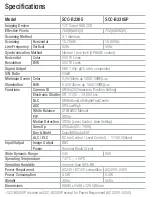
17
Liquid-assisted cooling
Forced air cooling is usually all that is needed to reach desired
levels of cooling. However, in warm weather, indoors, or other
particularly demanding situations, additional cooling can be
achieved with the optional Liquid Heat Exchanger, or LHX. The
LHX utilizes recirculating water for more efficient removal of heat
from the camera. All things being equal, the LHX can provide an
additional 7ºC to 10ºC of CCD cooling. It attaches to the rear of
the camera body as illustrated in the image to the right. The LHX
includes a thin thermal pad. Place the thermal pad between the
LHX and the camera body. Hold the LHX and pad in place with
the provided screws.
Water flows through the two hoses, coloured blue in this picture.
Self-sealing quick-disconnect couplings are used to attach the hoses to the LHX so that the
hoses can be removed easily without leakage of the recirculating water.
There are numerous ways of supplying recirculating water for the camera. One of the simpler
and more common methods for astro-photography is to place a small submersible pump into a 5
gallon plastic pail full of cool water. The temperature of this amount of water will rise by only a
few degrees after a full night of imaging. For additional details on the Liquid Heat Exchanger,
see the
Accessories
section below.
Note:
The fans can usually be turned off when using the LHX. In fact, the fans may actually
decreases the cooling ability if the air is warmer than the liquid. The cameras with the larger
style body (ie.QSI-6162) do not support the LHX unit.
Caution:
It is generally advised that only water be used in the LHX. Coolants such as ethylene
glycol and some solvents may damage the seals and gaskets.
How Much Cooling Is Enough?
Good results can be obtained with the CCD cooled to -10ºC when taking modest length
exposures. This is easy to achieve with forced air cooling on a QSI 600 Series camera when the
ambient air is at 25ºC (77ºF) or lower. For most CCDs used in QSI 600 Series cameras, dark
current is reduced by half for every ≈6ºC drop in the temperature of the CCD. Cooling from 26C
to -10ºC results in a 64-fold decrease in CCD dark current. For more demanding imaging and
longer exposures, lower temperatures are desirable. Cooling the CCD another 12ºC to -22ºC
lowers the dark current further to just 0.4% of the dark current at 26C. Cooling below -30ºC
results in a diminishing improvement as the noise from the dark current is outweighed by the
intrinsic read noise of the CCD itself. The camera will actively prevent the CCD from being
cooled below -40ºC.
















































